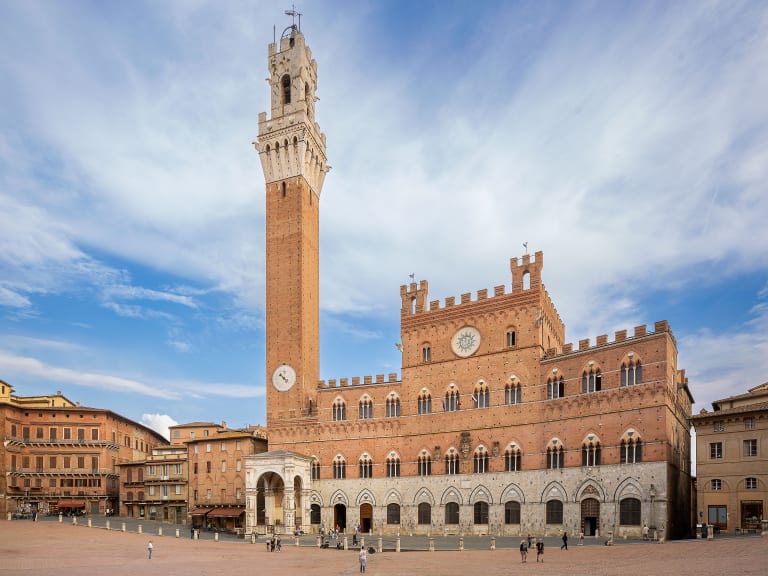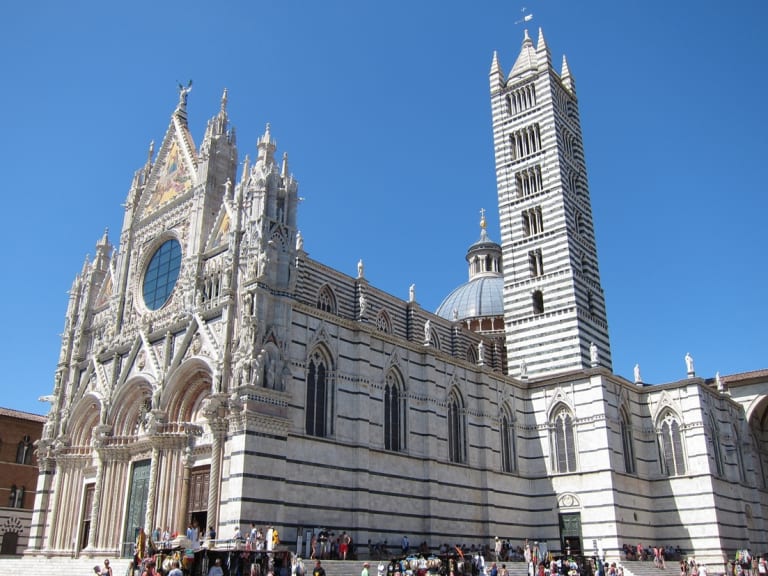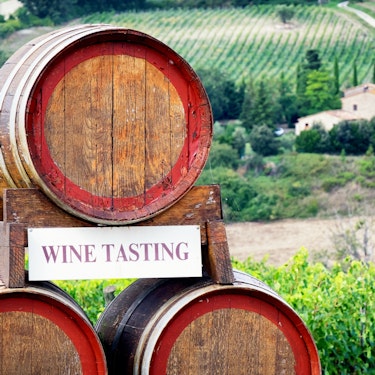More about: Siena in 1 Day: all you need to know
Siena is a grandiose city from every point of view. A city with a medieval feel where you will take a real trip back in time as you stroll through its streets and admire its magnificent buildings. Not in vain was it declared a World Heritage Site.
There is much to see and enjoy in this city, from admiring monuments with many centuries of history to visiting interesting museums, savouring its delicious gastronomy or tasting the good wines of the area. Even if you're only here for a day, with a little organisation you won't miss out on the best things to do in Siena.
1. Start your visit by admiring the Piazza del Campo

The Piazza del Campo is the real heart of Siena and therefore the starting point of any tour of the city. It is a magnificent medieval square, in fact, one of the largest of its kind in the world. It is well worth spending some time in it to savour all its details because there is a lot to see.
Although it is not easy to see it from the street, you will surely notice that its shape is unique: it imitates that of a shell or fan. And it is divided into nine parts, reminiscent of the Government of the Nine, the political regime that governed the Republic of Siena between 1287 and 1355.
Now pay attention to the buildings that surround it. The Palazzo Pubblico, the Torre del Mangia, the Capella della Piazza and the Gaia Fountain, among others. To walk around the square is to contemplate a living history lesson, as each building represents an important part of what the city has been.
I ask you now to make a small effort. Imagine the square decked out for the horse race that every year pits the neighbourhoods of Siena against each other. The Palio is held on 2 July and 16 August. You may not be able to see it, but you can almost feel the excitement here. On your tour of the city, you will also see many nods to this tradition.
2. Visit the Palazzo Pubblico and the Museo Civico

If there is one building that stands out in Piazza del Campo it is the Palazzo Pubblico. It was completed at the beginning of the 14th century, but its beauty and the height of its tower still amaze visitors.
Here is a little curiosity. Already during its construction, the building was so harmonious and beautiful that the authorities took a singular decision. They forced the rest of the buildings in the square to be built following their stylistic canons, but forbidding them to compete in height and sumptuousness with the palace.
This building has been the centre of political power in Siena from the very moment of its construction, but today it does not only house the Town Hall. Part of its rooms is occupied by the Civic Museum, one of the best museums in Siena.
Inside the museum you can admire rooms adorned with marvellous frescoes. One of the most outstanding is the Allegory of Good and Bad Government by Ambrogio Lorenzetti. If you like art, don't miss a visit to the Museo Civico.
Interesting facts
- Opening hours of the Palazzo Pubblico and the Museo Civico: from 10:00 am to 6:00 pm in winter and from 10:00 am to 7:00 pm in summer.
- Price: about 10 euros for general admission. Families, children, seniors and disabled persons get a discount.
3. Climb the Torre del Mangia

You'll have to look up a lot to see the top because this tower is a real medieval skyscraper: it's no less than 88 metres high. If you're wondering, yes, you can climb to the top, but you'll have to face 400 steps.
If you're in decent shape, my recommendation is that you make the effort to go up. From the top of the Mangia tower you will have the most incredible views not only of Siena, but also of a wonderful part of the Tuscan countryside, with its hills full of vines and olive trees.
And a curiosity related to the name of the tower. It was named after the first bell ringer it had. The man's name was Giovanni di Balduccio, but at the time he was known as "Mangiaguadagni". The reason? Because he spent everything he earned in the taverns of Siena.
Interesting facts
- Opening hours of the Torre del Mangia: from 10.00 am to 4.00 pm in winter and from 10.00 am to 7.00 pm in summer.
- Price: about 10 euros for general admission. There is a discount for families and children under the age of 11 get in free.
4. Go to Palazzo Salimbeni by walking around the historic centre

The area around Piazza del Campo hides a fabulous network of medieval streets full of palaces. No matter which one you decide to follow, you are sure to find an architectural gem. In any case, I recommend you look for Via Bianchi di Sopra and stroll along it. It is one of the most essential streets in Siena.
In Bianchi di Sopra you will see the Croce del Travaglio, the meeting point of some of the main roads in Siena. You will also come across palatial buildings along the way, such as the Palazzo Tolomei or the Palazzo de Gori Pannolini. If you don't want to miss anything, you can always sign up for one of the guided tours of Siena.
On your own or with a guide, you should leave this street to get to Palazzo Salimbeni. It is a beautiful Gothic building that today houses the headquarters of one of Italy's major banks. In the same square there are two other treasures of Siena: Palazzo Spannocchi and Palazzo Cantucci.
5. Visit the Basilica of St. Dominic

If there is one thing that is sure to strike you about the Basilica of St. Dominic, it is its size. I recommend a visit not only to admire its sober Gothic architecture. It is also for its location. The church stands on Camporegio Hill, from where you can enjoy beautiful views of the city and the Duomo.
As a curiosity, the basilica houses some relics that are particularly appreciated by devotees, including the sacred head of Saint Catherine of Siena. By the way, a short walk away you can visit the sanctuary home of the saint, from which you will have another fantastic view of Siena.
6. Where to eat in Siena

There is a lot to see in Siena, so it is essential to recharge your batteries. The area around Piazza del Campo and Via Bianchi di Sopra is where you'll find the highest concentration of eateries. You can choose from small taverns, osterias or elegant restaurants.
If you want a quick bite to eat, I recommend the Salumeria Il Cencio. It is in Piazza del Campo and you can eat delicious paninis. By the way, don't miss the terrace to see the views of the square, they are incredible.
There are other fantastic places to eat, such as Mugolone, Osteria le Logge, Taverna di San Giuseppe or Campo Cedro, but really in Siena you can eat very well almost anywhere and at affordable prices.
What to try? Pici, the typical pasta of the area; gnudi, spinach and sheep ricotta fritters; ribollita, a kind of vegetable and legume soup; chiantina, a high quality veal meat; or meat from the cinta senese, a breed of pig. If you want more, you can take one of the culinary tours of Siena.
7. Tour the Duomo of Siena

Siena Cath edral is considered one of the most beautiful cath edrals in Italy and in the world. You will see the reason for this long before you get there, but especially when you visit the interior.
The church was built between 1215 and 1263 in Italian Gothic style and its exterior is covered in white and green marble. But look especially at its façade, which is full of details, such as the rose window and the golden mosaics that decorate it.
But it is what awaits you inside that is sure to leave you speechless. The floor is decorated with scenes made of coloured marble, the pulpit and the altar are real gems. You can also admire works by Donatello and Michelangelo. And then there is the play of light that the stained glass windows create in the naves, which will leave you speechless.
And that's not all. We should also mention the Piccolomini Library, with a decoration reminiscent of the Vatican's Sistine Chapel. And if that's not enough, don't miss the Puerta del Cielo, a visit to the roofs of the cathedral will give you the most spectacular interior and exterior panoramic views.
Interesting facts
- Opening times: depend on the season, as well as on whether it is a public holiday or the day before a public holiday. Opening times may also vary from the cathedral to the crypt, the Porta del Cielo or the Piccolomini Library, so it is advisable to enquire in advance and purchase tickets.
- Price: it also depends on the type of visit and the season. In general, from 7 euros for the Cathedral and the Piccolomini Library. There is a combined ticket which allows you to visit the roofs and the cathedral museums and costs about 15 euros.
8. Visit the Duomo Nuovo and the Museo dell'Opera

The cathedral is the living example of Siena's greatest splendour. But it is not all there is to it. Behind it you will see an unfinished façade. This was to be the monumental entrance to the Duomo after an extension designed in the 14th century that was to quadruple the size of the temple.
But the plague, the crisis and some construction problems came and everything came to a standstill. From that pharaonic project the half-finished façade and parts of an aisle have survived to the present day, now occupied by the Museo dell'Opera del Duomo.
If you are interested in art, don't hesitate to spend some time touring the rooms of this museum. During the visit you will have the opportunity to admire an interesting collection of works of art, some of them by artists of the stature of Giovanni Pisano and Donatello.
But you can do even more in the Duomo Nuovo: climb the Facciatone, that imposing façade that was never finished. From its terrace you can admire one of the best views of Siena. Of course, you will have to climb 200 steps to reach it, but I assure you it will be well worth the effort.
Interesting facts
- Opening hours: the Museo dell'Opera and the Panorama of the Facciatone are usually open from 10:00 to 19:00 in summer and from 10:00 to 17:30 in winter. However, opening hours may vary on public holidays and the eve of public holidays.
- Price: I recommend buying the combined pass which allows entry to all the areas of the Duomo and whose general price is about 15 euros. There are reduced-price tickets for children up to the age of 11.
9. Entrance to the Baptistery of St. John the Baptist

This is another of the Gothic treasures you will find next to the cathedral. The baptistery is right behind it and its interior hides a number of artistic gems, including the magnificent frescoes that decorate its vault and its three naves. They have nothing to envy to those of other historic buildings in the city.
But pay special attention to the baptismal font in the centre. It is a real jewel made of bronze and marble. Great artists, including Ghiberti and Donatello, worked on its design and creation. The visiting hours of the baptistery are the same as those of the cathedral.
10. Discover the Santa Maria della Scala Hospital

In the same square where the Duomo stands you will see another building which I recommend you stop at if you have time. The Hospital of Santa Maria della Scalla has functioned since the 12th century and until not so long ago as a hospital, a centre for the reception of pilgrims and a hospice. Today it is a magnificent museum that is well worth a visit.
Along the route you can admire rooms magnificently decorated with 15th century frescoes. But the building also houses the National Archaeological Museum and the Treasury of Santa Maria La Scala, a collection of reliquaries, jewellery and miniatures among other objects from ancient Constantinople.
One more note. I'm sure you've noticed the Gaia Fountain in the Piazza del Campo. It is not the original. The authentic sculptural ensemble is in this museum.
Interesting facts
- Opening hours: the hospital opens at 10 am, but the closing time depends on the season and the day of the week. On Thursdays it usually closes at 10 p.m.
- Price: general admission costs around 7 euros and reduced admission costs around 4 euros. There are discounts for families and children under the age of 11, young children and the disabled are free.
11. Stand in front of Palazzo Chigi Saracini

Halfway between Piazza del Campo and the Duomo is one of Siena's most unique buildings. It is in a narrow street and has a peculiarity that will make you not overlook it: its curved façade, with a first floor made of stone and a second floor of brick full of pointed windows.
Today this palace, built in the 12th century, houses a renowned musical institution in Siena, the Accademia Musicale Chigiana. It can only be toured on guided tours that allow you to discover an interesting gallery of paintings and a rococo concert hall, among other treasures.
12. End the day with a very special dinner

To end the visit, there is nothing like sitting quietly on one of the many terraces set up in the Piazza del Campo, weather permitting. It is one of the best things to do in Siena in the evening.
If it is not too late, I recommend a traditional aperitif. You can order a glass of chianti, the local wine, and accompany it with a cheese and charcuterie board. The taste and aroma of the food and drink, together with the image of the illuminated piazza, will give you the best memories of Siena.




